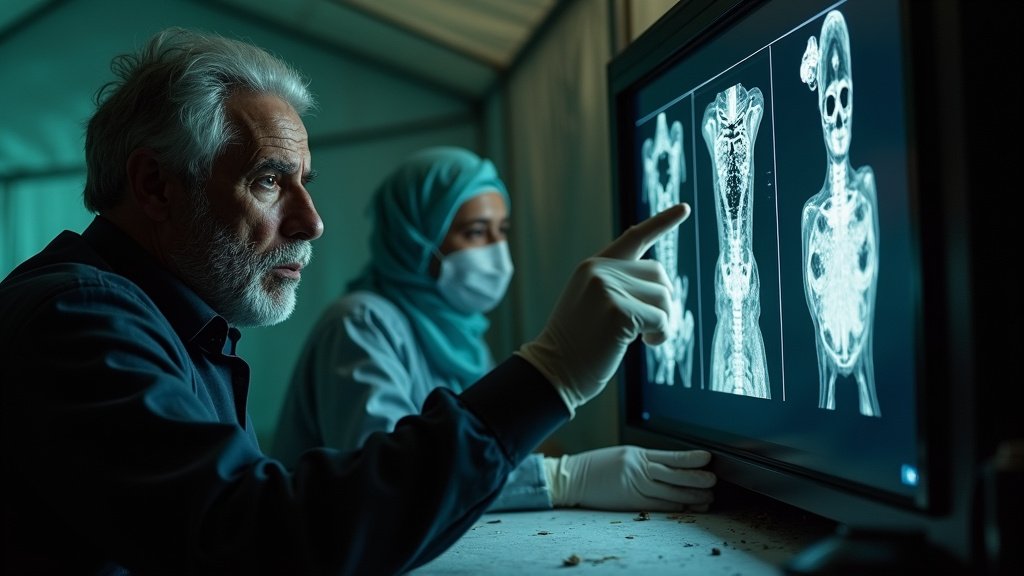Amidst a fragile ceasefire that has brought a temporary halt to hostilities, Palestinian families in Gaza are engaged in a deeply distressing and agonizing task: **Gaza bodies identification**. The process is fraught with difficulty, exacerbated by the condition of the remains and a severe lack of resources, painting a grim picture of the ongoing Gaza humanitarian crisis and the challenges of **Gaza bodies identification**.
The Grim Task of Gaza Bodies Identification Amidst Ruin
At Nasser Hospital in Khan Yunis, medical teams and distraught families are undertaking the painstaking effort to identify dozens of Palestinian bodies handed over by Israeli authorities. These remains arrived without names, marked only with numerical codes, making the task of **Gaza bodies identification** a desperate visual search against large screens displaying difficult images. Many of the bodies bear horrific signs of abuse, including extensive torture, execution marks, burn damage, and bullet wounds to the head, with some showing evidence of being blindfolded and having their hands and feet bound. The ongoing struggle for **Gaza bodies identification** is a critical aspect of the current situation for Gaza conflict victims.
Forensic experts in Gaza are working with very basic tools, lacking the advanced DNA testing and modern equipment available in Israel. This deficiency forces reliance on visual identification, often proving nearly impossible due to the condition of the bodies, some of which are decomposed or partial remains. Authorities estimate that around 9,500 people remain missing in Gaza, leaving families to grapple with the uncertainty of their fate and the harrowing reality of **Gaza bodies identification** under such conditions. The challenges in **Gaza bodies identification** are immense, impacting the search for missing persons Gaza.
Signs of Abuse and Unanswered Questions in Gaza Bodies Identification
Doctors and forensic teams have reported substantial evidence of beatings, summary executions, strangulation marks, broken bones, and mutilation among the returned Palestinian bodies. Some of the deceased are believed to have been killed on October 7, 2023, with some accounts suggesting bodies were run over by Israeli military tanks. The Israeli authorities have not provided accompanying data, fueling suspicions that this withholding of information is intended to prolong the suffering of grieving families. This practice of withholding bodies, often buried in unmarked sites known as “cemeteries of numbers,” has been a long-standing policy, though it contravenes humanitarian law and complicates **Gaza bodies identification**.
Hostage Remains and Hamas’s Claims Amidst Gaza Bodies Identification Efforts
Concurrently, Hamas has been returning the remains of Israeli hostages as part of the same US-brokered ceasefire agreement. Hamas stated it has handed over all deceased Israeli hostages it could recover, but requires specialized equipment and extensive efforts to locate and retrieve remaining bodies buried beneath the immense rubble of Gaza. The group has indicated that finding more bodies is difficult due to the scale of destruction, estimating 55 million tons of debris must be cleared before Gaza reconstruction can begin. The ongoing issue of **Gaza bodies identification** and Israeli hostages Gaza remains has put significant strain on the fragile Gaza ceasefire, with Israel threatening to resume fighting if Hamas fails to fully comply with the terms of the deal.
Broader Context: Ceasefire Strains and Reconstruction Needs in Gaza
The challenges in identifying bodies and returning all hostage remains are adding significant tension to the ongoing Gaza ceasefire. Hamas official Mohammed Nazzal has indicated the group intends to maintain security control in Gaza during an interim period and cannot commit to disarmament, complicating US plans for post-war governance. Meanwhile, Israel’s Defense Minister Israel Katz has ordered the military to prepare a comprehensive plan to “defeat Hamas” should the group fail to uphold the agreement. The need for effective **Gaza bodies identification** is a constant reminder of the human toll.
The scale of devastation in Gaza is immense, with the United Nations Development Programme (UNDP) estimating that 55 million tons of debris need clearing for reconstruction, which is projected to cost approximately $70 billion. The destruction has rendered much of the territory uninhabitable, with hundreds of thousands of housing units damaged or destroyed. Amidst this catastrophic landscape, the immediate struggle for families in Gaza to identify their dead through **Gaza bodies identification** is a stark reminder of the immense human cost of the conflict, becoming a significant piece of Gaza news that is trending worldwide. The plight of missing persons Gaza is deeply tied to these identification efforts.
Awaiting Closure Amidst Uncertainty in Gaza Bodies Identification
As the ceasefire holds precariously, the dual processes of identifying Palestinian conflict victims and returning Israeli hostages’ remains continue to highlight the profound humanitarian and political complexities. For the families in Gaza, the quest for **Gaza bodies identification** is not merely a procedural matter but a desperate search for closure and dignity for their lost loved ones, a quest made all the more agonizing by the visible evidence of abuse and the profound destruction surrounding them. The work of forensic experts Gaza is crucial in this process.
Further reading: Related News on Google




